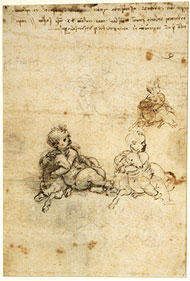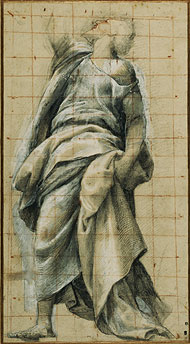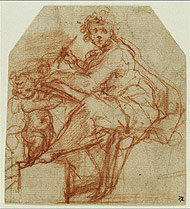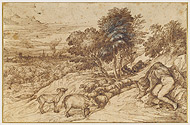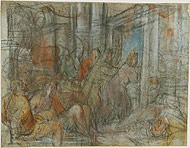|
This exhibition offers highlights from the Getty's collection of North Italian Renaissance drawings, focusing on the work and influence of Leonardo da Vinci and Titian.
Italy in the 1400s and 1500s was a patchwork of dukedoms and principates, with artists often connected to particular courts. Artists in the northern regions Italy—Lombardy, Emilia-Romagna, and the Veneto—had diverse approaches to drawing, working with different materials and developing distinctive regional styles and effects.
|
 |
|
Lombardy was artistically dominated by Leonardo da Vinci, who was a prolific draftsman as well as a painter, inventor, mathematician, naturalist, and philosopher.
The drawing above shows Leonardo's technique of scattering varied studies across the page, which was widely influential. It features poses for the Christ Child with a lamb, probably made in preparation for the large drawing Virgin and Child with St. Anne and a Lamb, which is now lost. The inscription at the top concerns a 12th-century treatise on geometry.
The back of this drawing contains another study of the Christ Child with a lamb, as well as a detailed design for a laminating machine. Leonardo anticipated wear and tear on the axle and proposed a replaceable axle (polo rimessibile), which he noted in his characteristic "back to front" mirror writing under the sketch.
  See a sample of Leonardo's writing. See a sample of Leonardo's writing.
|
 |
|
An unidentified apostle stands on a wall above us in this dramatic drawing. The artist, Bernardino Gatti, adopted Leonardo's technique of using white highlights to show the volume of the drapery.
As he drew, Gatti moved the apostle's left foot to a more precarious position on the wall, resulting in two sets of toes.
This drawing was made in preparation for a ceiling fresco. The red chalk grid drawn over the figure was a tool to help the artist transfer the proportions of the figure to the fresco surface.
|
 |
|
Parma, Ferrara, and Bologna were the artistic centers of Emilia-Romagna.
Correggio (named after his birthplace, Correggio) worked in Parma and pioneered a graceful, soft style.
Parmigianino, also named after his birthplace, drew incessantly in a distinctive, elegant style characterized by voluminous figures with elongated limbs and small heads.
Later in the 16th century, artists Lodovico Carracci, Annibale Carracci, and Agostino Carracci favored naturalism and returned to the practice of drawing from life.
In this drawing of Saint Matthew by Correggio, the saint looks out from the sheet as an angel supports his book. Saint Matthew is traditionally identified as the author of the first gospel.
Correggio made this drawing with great speed as an early idea for a fresco for the church of San Giovanni Evangelista in Parma. He smudged the facial features of the saint to create a sense of softness and intensity.
|
 |
|
Parmigianino was a fluent draftsman who made hundreds of drawings, most of them in preparation for paintings.
Here he rapidly sketched the Holy Family in two possible groupings, turning the paper around as he worked. The grouping at the bottom, with brown wash and gouache, is the more highly finished of the two.
The figures are characteristic of Parmigianino's style—they have small heads, expansive drapery, and over-long limbs.
|
 |
|
The creative process in Venice centered on color rather than drawing. Draftsmen in Venice and the Veneto, of whom Titian and Tintoretto were the most accomplished, often used black chalk on blue-colored paper. These materials emphasized the fragmented forms, strong light and shade, and atmospheric effects they preferred.
Titian was a pioneer of landscape imagery. He used an extraordinary variety of pen lines to create the intensely atmospheric landscape shown above. It has a variety of textures, from the short spiky hair of the wild boar in the foreground (see detail) to the sinuous spirals of smoke at back left (see detail).
The drawing includes some unexplained elements: the woman covering, or uncovering, herself, and the goat and wild boar alongside a flock of sheep. The drawing could be an allegory of Autumn with the lament of Venus or an allegory of laziness leading to lust.
|
 |
|
This extraordinary sheet demonstrates the richness of tone and color in Venetian drawing. Jacopo Bassano strove for pictorial effect with little concern for detail or line. The shadowy money changers flood out the door at the right; Christ is probably the figure at center left with his left arm raised.
Bassano adopted an unusual technique for this drawing, combining blue paper not only with natural black chalk but also with a variety of fabricated colored chalks.
The exhibition is located at the Getty Center, Museum, East Pavilion.
|
 |
